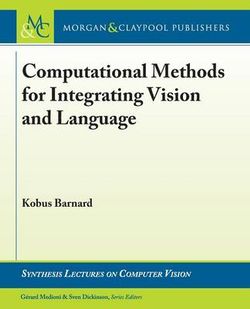Modeling data from visual and linguistic modalities together creates opportunities for better understanding of both, and supports many useful applications. Examples of dual visual-linguistic data includes images with keywords, video with narrative, and figures in documents. We consider two key task-driven themes: translating from one modality to another (e.g., inferring annotations for images) and understanding the data using all modalities, where one modality can help disambiguate information in another. The multiple modalities can either be essentially semantically redundant (e.g., keywords provided by a person looking at the image), or largely complementary (e.g., meta data such as the camera used). Redundancy and complementarity are two endpoints of a scale, and we observe that good performance on translation requires some redundancy, and that joint inference is most useful where some information is complementary.
Computational methods discussed are broadly organized into ones for simple keywords, ones going beyond keywords toward natural language, and ones considering sequential aspects of natural language. Methods for keywords are further organized based on localization of semantics, going from words about the scene taken as whole, to words that apply to specific parts of the scene, to relationships between parts. Methods going beyond keywords are organized by the linguistic roles that are learned, exploited, or generated. These include proper nouns, adjectives, spatial and comparative prepositions, and verbs. More recent developments in dealing with sequential structure include automated captioning of scenes and video, alignment of video and text, and automated answering of questions about scenes depicted in images.
- ISBN:
- 9781608451128
- 9781608451128
-
Category:
- Computer vision
- Format:
- Paperback
- Publication Date:
-
30-04-2016
- Publisher:
- Morgan & Claypool Publishers
- Country of origin:
- United States
- Pages:
- 227
- Dimensions (mm):
- 235x191x12mm
- Weight:
- 0.44kg
This title is in stock with our Australian supplier and should arrive at our Sydney warehouse within 1-2 weeks of you placing an order.
Once received into our warehouse we will despatch it to you with a Shipping Notification which includes online tracking.
Please check the estimated delivery times below for your region, for after your order is despatched from our warehouse:
ACT Metro 2 working days
NSW Metro 2 working days
NSW Rural 2-3 working days
NSW Remote 2-5 working days
NT Metro 3-6 working days
NT Remote 4-10 working days
QLD Metro 2-4 working days
QLD Rural 2-5 working days
QLD Remote 2-7 working days
SA Metro 2-5 working days
SA Rural 3-6 working days
SA Remote 3-7 working days
TAS Metro 3-6 working days
TAS Rural 3-6 working days
VIC Metro 2-3 working days
VIC Rural 2-4 working days
VIC Remote 2-5 working days
WA Metro 3-6 working days
WA Rural 4-8 working days
WA Remote 4-12 working days




Share This Book: